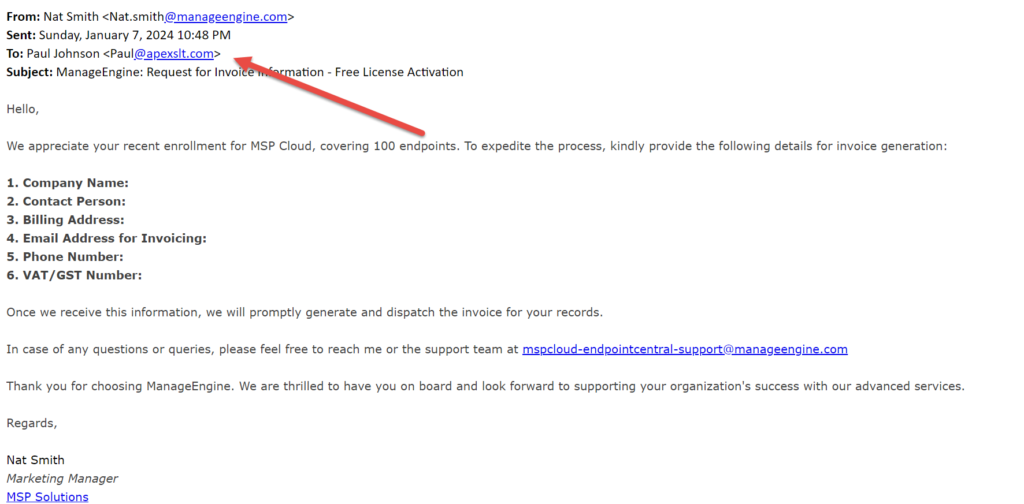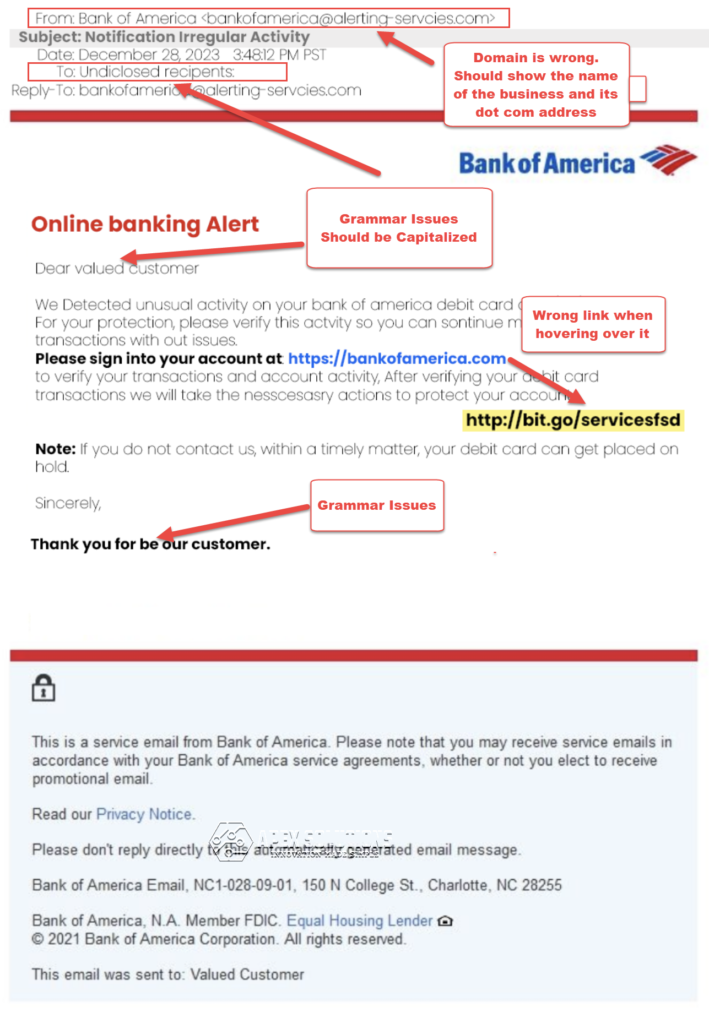{all about phishing scams}
Unveiling the World of Phishing Email Examples for Training
Recognizing Phishing Scams: Real-Life Examples for Education
The anatomy of phishing email
and what to look for
In an era dominated by digital communication, email serves as a cornerstone for exchanging information, conducting business, and staying connected with friends and colleagues. However, with the convenience and ubiquity of email come insidious threats that can jeopardize our personal and professional lives. Email phishing, a devious form of cybercrime, has grown exponentially in recent years, posing a grave risk to individuals and organizations alike.
Phishing email examples for training: Understanding Email Phishing
Email phishing is a malicious technique that involves impersonating legitimate entities, often through deceptive emails, in an attempt to steal sensitive information, spread malware, or gain unauthorized access to systems. Cybercriminals craft cunning phishing email templates that mimic trusted sources, making it challenging for recipients to discern their authenticity. These phishing email examples exploit psychological triggers, such as urgency or fear, to manipulate victims into taking actions detrimental to their security.
The Pervasive Threat of Email Phishing
The scale of the email phishing problem is staggering. According to recent cybersecurity reports, phishing attacks have surged dramatically, with millions of phishing email scams infiltrating inboxes daily. The consequences of falling victim to these scams can be devastating, leading to compromised accounts, financial losses, identity theft, and even corporate data breaches. For instance, example of good phishing email account compromised situations have become alarmingly common, causing considerable harm to individuals and organizations.
A Glimpse into the Deceptive World
To grasp the gravity of the situation, let’s examine some real-life examples of phishing email templates and their devastating effects. Ransomware email examples demonstrate how cybercriminals can lock individuals and organizations out of their own data, demanding hefty ransoms for decryption keys. Meanwhile, the most common spam emails flood inboxes with fraudulent offers, counterfeit products, and malicious links. Such examples of spam emails illustrate how attackers exploit the sheer volume of messages to conceal their harmful intentions.
The Imperative for Training and Awareness
Recognizing the intricacies of email phishing is essential for safeguarding personal and professional information. By exploring example of phishing email incidents and understanding spam email examples, individuals and organizations can bolster their defenses. Vigilance and education are paramount, and this blog will serve as a valuable resource in achieving that goal.
In the following sections, we will delve deeper into the tactics employed by cybercriminals, dissecting phishing email examples for training purposes. By staying informed and proactive, we can fortify our defenses against this pervasive menace and ensure the security of our digital lives.
Understanding Different types of Phishing Attacks
Before diving into the specifics, it’s essential to establish a foundational understanding of phishing. In essence, phishing involves malicious actors impersonating trusted entities to trick victims into revealing sensitive information, downloading malware, or executing harmful actions.
1.Phishing Email Examples Great For Training: The Most Common Threat
Email phishing is the most known and most used form of this phishing scam attempts. In this scenario, attackers send deceptive emails that looks legitimate, such as banks, government agencies, or popular websites. The main objective of this type of phishing is to lure recipients into clicking malicious links, sharing personal information, or downloading infected attachments. As you can see in our example of phishing email image, starting from the top going down.
a. This is an example of bad emails. The From: email section shows the wrong domain. Its showing something completely different. This should show the brands domain name. In this example, it should show @bankofamerica.com and not @alerting-servcies.com.
b. Look for bad grammar. Having bad grammar is one of the most common spam email signs. Big brands like Bank of America should have zero bad grammar within their emails.
c. Clicking on hyperlinks are something you have to be very careful about. If you hover your mouse cursor over the link, you will be able to see the URL that its linking to. In this phishing email example. You can see that the URL is very different then what is shown on text.
d. More grammar issues are displayed. Using this phishing examples, you’ll have a leg up on your next spam emails
2. Spear Phishing: A Targeted Approach
Spear phishing represents a more focused strategy, demanding meticulous research on the intended victim. Cybercriminals collect personal information and craft highly tailored emails. These messages often appear to come from someone the recipient knows and trusts – a colleague, boss, or acquaintance. This personalized touch dramatically increases the likelihood of success.

5 Types of spear phishing explained
a. Standard Spear Phishing
The foundation of spear phishing lies in customization. Cybercriminals craft emails with tailored messages, often addressing the recipient by name and referencing specific details that make the email appear legitimate. This personalization can lull victims into a false sense of security, increasing the likelihood of them falling for the scam.
Now, let’s explore a more deceptive variation.
b. CEO Fraud
CEO fraud is a subtype of spear phishing that exclusively targets high-ranking executives within an organization. Attackers convincingly impersonate the CEO or another top official, using their authority to demand urgent actions, such as initiating financial transfers or disclosing sensitive company information. The pressure of dealing with a seemingly urgent request from a superior can lead to disastrous outcomes
c. Vendor Email Compromise (VEC)
Vendor Email Compromise, or VEC, exploits relationships between an organization and its trusted vendors or suppliers. Attackers compromise the vendor’s email account and use it to send seemingly legitimate requests for payment or changes in bank account information. The familiarity of the sender and the plausible transaction context make VEC attacks highly convincing.
d. State-Sponsored Spear Phishing
State-sponsored spear phishing attacks are typically carried out by nation-states or their affiliates. These attacks are meticulously planned and executed to target specific individuals or organizations for espionage, intelligence gathering, or other strategic purposes. Such attacks often involve advanced techniques, such as zero-day exploits and sophisticated social engineering.
Lastly, we’ll explore a more recent and increasingly prevalent form of spear phishing.
e. Business Email Compromise (BEC)
Business Email Compromise, or BEC, has gained prominence in recent years. It involves targeting employees responsible for financial transactions or managing sensitive data. Cybercriminals use social engineering tactics to impersonate these individuals, convincing employees to transfer funds or reveal sensitive information. BEC attacks can lead to substantial financial losses and data breaches.
3. Whaling Attacks: Targeting the Titans
Whaling attacks, also known as CEO fraud, aim to target high-profile individuals within an organization, such as CEOs or executives. Perpetrators impersonate these senior figures to request urgent financial transfers or sensitive information. The pressure to respond quickly can lead to catastrophic consequences.
Now, let’s explore a phishing attack that exploits fear and urgency.
4. Pharming Attacks
Pharming attacks don’t rely on deceptive emails but rather manipulate the domain name system (DNS). Cybercriminals redirect users to fraudulent websites that appear legitimate. Victims unknowingly provide sensitive information, thinking they are on a trusted platform.
Shifting gears, we come across a type of phishing attack that combines elements of phishing and malware distribution.
5. Vishing Attacks
Vishing, or voice phishing, takes place over the phone. Attackers pose as legitimate entities, such as banks or tech support, and persuade victims to reveal sensitive information or download malware by phone. This form of social engineering can be highly convincing.
Finally, let’s address a multifaceted phishing attack that incorporates elements of various other types.
6. Smishing Attacks
Smishing, a portmanteau of SMS and phishing, involves malicious text messages. Victims receive deceptive SMS messages containing links or requests for sensitive information. These messages can lead to financial fraud or compromise mobile devices.
Conclusion
In this era of pervasive online presence, the menace of phishing attacks looms larger than ever before. Understanding the various types of phishing attacks, including Phishing Email Examples for Training, is the initial stride toward fortifying both our personal security and that of our organizations. Through continuous awareness and unwavering vigilance, we can effectively shield our digital lives from these insidious tactics, empowering ourselves against potential threats.




